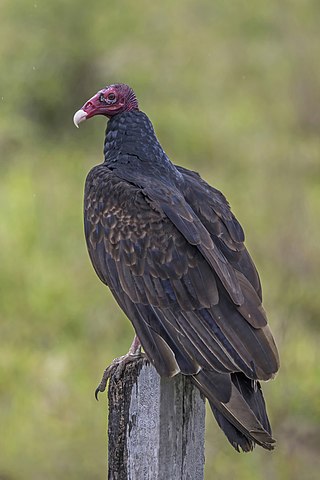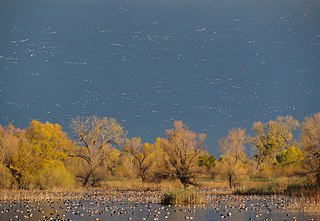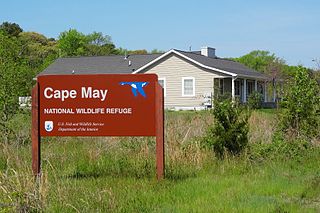
Birds of prey or predatory birds, also known as raptors, are hypercarnivorous bird species that actively hunt and feed on other vertebrates. In addition to speed and strength, these predators have keen eyesight for detecting prey from a distance or during flight, strong feet with sharp talons for grasping or killing prey, and powerful, curved beaks for tearing off flesh. Although predatory birds primarily hunt live prey, many species also scavenge and eat carrion.

Hawks are birds of prey of the family Accipitridae. They are very widely distributed and are found on all continents except Antarctica.

The osprey, historically known as sea hawk, river hawk, and fish hawk, is a diurnal, fish-eating bird of prey with a cosmopolitan range. It is a large raptor, reaching more than 60 cm (24 in) in length and 180 cm (71 in) across the wings. It is brown on the upperparts and predominantly greyish on the head and underparts.

The turkey vulture is the most widespread of the New World vultures. One of three species in the genus Cathartes of the family Cathartidae, the turkey vulture ranges from southern Canada to the southernmost tip of South America. It inhabits a variety of open and semi-open areas, including subtropical forests, shrublands, pastures, and deserts.

Bird migration is a seasonal movement of birds between breeding and wintering grounds that occurs twice a year. It is typically from north to south or from south to north. Migration is inherently risky, due to predation and mortality.

Buteo is a genus of medium to fairly large, wide-ranging raptors with a robust body and broad wings. In the Old World, members of this genus are called "buzzards", but "hawk" is used in the New World. As both terms are ambiguous, buteo is sometimes used instead, for example, by the Peregrine Fund.

Cooper's hawk is a medium-sized hawk native to the North American continent and found from southern Canada to Mexico. This species was formerly placed in the genus Accipiter. As in many birds of prey, the male is smaller than the female. The birds found east of the Mississippi River tend to be larger on average than the birds found to the west. It is easily confused with the smaller but similar sharp-shinned hawk.

The broad-winged hawk is a medium-sized hawk of the genus Buteo. During the summer, some subspecies are distributed over eastern North America, as far west as British Columbia and Texas; they then migrate south to winter in the Neotropics from Mexico south to southern Brazil. Other subspecies are all-year residents on Caribbean islands. As in most raptors, females are slightly larger than males. Broad-winged hawks' wings are relatively short and broad with a tapered, somewhat pointed appearance. The two types of coloration are a dark morph with fewer white areas and a light morph that is more pale overall. Although the broad-winged hawk's numbers are relatively stable, populations are declining in some parts of its breeding range because of forest fragmentation.

A kettle, sometimes called a tea kettle or teakettle, is a device specialized for boiling water, commonly with a lid, spout, and handle. There are two main types: the stovetop kettle, which uses heat from a hob, and the electric kettle, which is a small kitchen appliance with an internal heating element.

The Marin Headlands are a hilly peninsula at the southernmost end of Marin County, California, United States, located just north of San Francisco across the Golden Gate Bridge, which connects the two counties and peninsulas. The entire area is part of the Golden Gate National Recreation Area. The Headlands are famous for their views of the Bay Area, especially of the Golden Gate Bridge.

A flyway is a flight path used by large numbers of birds while migrating between their breeding grounds and their overwintering quarters. Flyways generally span continents and often pass over oceans. Although applying to any species of migrating bird, the concept was first conceived and applied to waterfowl and shore birds. The flyways can be thought of as wide arterial highways to which the migratory routes of different species are tributaries. An alternative definition is that a flyway is the entire range of a migratory bird, encompassing both its breeding and non-breeding grounds, and the resting and feeding locations it uses while migrating. There are four major north–south flyways in North America and six covering Eurasia, Africa, and Australasia.

The Loess Hills are a formation of wind-deposited loess soil in the westernmost parts of Iowa and Missouri, and the easternmost parts of Nebraska and Kansas, along the Missouri River.

The Cape May National Wildlife Refuge is a protected area on the Cape May Peninsula in Cape May County, New Jersey. It is part of the National Wildlife Refuge System and managed by the United States Fish and Wildlife Service. Established in January 1989 with 90 acres (0.36 km2) acquired from the Nature Conservancy, it has since grown to more than 11,000 acres (45 km2) in size, and plans call for its further expansion to more than 21,200 acres (86 km2). It comprises three distinct and non-contiguous units: the Delaware Bay Division, the Great Cedar Swamp Division and the Two Mile Beach Unit. Located in the Middle Atlantic coastal forests ecoregion, the cape provides habitat for large numbers of migratory birds.

Hawking is a feeding strategy in birds involving catching flying insects in the air. The term usually refers to a technique of sallying out from a perch to snatch an insect and then returning to the same or a different perch, though it also applies to birds that spend almost their entire lives on the wing. This technique is called "flycatching" and some birds known for it are several families of "flycatchers": Old World flycatchers, monarch flycatchers, and tyrant flycatchers; however, some species known as "flycatchers" use other foraging methods, such as the grey tit-flycatcher. Other birds, such as swifts, swallows, and nightjars, also take insects on the wing in continuous aerial feeding. The term "hawking" comes from the similarity of this behavior to the way hawks take prey in flight, although, whereas raptors may catch prey with their feet, hawking is the behavior of catching insects in the bill. Many birds have a combined strategy of both hawking insects and gleaning them from foliage. Mainly founded in the grass lands and from dark oak wood fort trees.

Pack Monadnock or Pack Monadnock Mountain 2,290 feet (700 m), is the highest peak of the Wapack Range of mountains and the highest point in Hillsborough County, New Hampshire. The mountain, a monadnock, is located in south-central New Hampshire within the towns of Peterborough and Temple. The 22 mi (35 km) Wapack Trail and a number of shorter trails traverse the mountain. A firetower and ledges on the summit offer long views north to the White Mountains, west to Mount Monadnock, and south into Massachusetts. North Pack Monadnock Mountain is located directly to the north along the Wapack ridgeline; Temple Mountain to the south.

Hawk Mountain Sanctuary is a wild bird sanctuary in Albany Township and East Brunswick Township, located along the Appalachian flyway in eastern Pennsylvania. The sanctuary is a prime location for the viewing of kettling and migrating raptors, known as hawkwatching, with an average of 20,000 hawks, eagles and falcons passing the lookouts during the late summer and fall every year.

Raptor conservation concerns are threats affecting the population viability of birds of prey. Because of their hunting lifestyle, raptors face distinct conservation challenges. As top predators, they are important for healthy ecosystem functioning, and by protecting them many other species are safeguarded. Their extensive habitat requirements make regional conservation strategies necessary for protecting birds of prey.
Hawk Hill is a 923-foot (281 m) peak in the Marin Headlands, just north of the Golden Gate Bridge and across the Golden Gate strait from San Francisco, California. The hill is within the Golden Gate National Recreation Area.

Swainson's hawk is a large bird species in the Accipitriformes order. This species was named after William Swainson, a British naturalist. It is colloquially known as the grasshopper hawk or locust hawk, as it is very fond of Acrididae and will voraciously eat these insects whenever they are available.

Hawkwatching is a mainly citizen science activity where experienced volunteers count migratory raptors in an effort to survey migratory numbers. Groups of hawkwatchers often congregate along well-known migratory routes such as mountain ridges, coastlines and land bridges, where raptors ride on updrafts created by the topography. Hawkwatches are often formally or informally organized by non-profit organizations such as an Audubon chapter, state park, wildlife refuge or other important birding area. Some hawkwatches remain independent of any organizing structure.



















